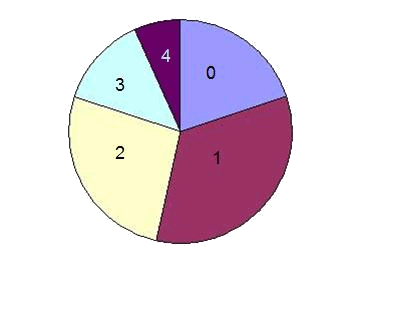The diagram of sectors is usually used for qualitative variables, but it can also be used to represent discrete data.
It consists on dividing a circle so that the most frequent values have bigger sectors. To calculate the angle of the sector of each value we use the following expression: $$$\displaystyle \alpha_i=f_i \cdot \frac{360^\circ}{N}$$$
where $$N$$ is the number of data, and $$f$$ is the frequency corresponding to the angle alpha.
The following table shows the value of the angle for every number of brothers using this example:
$$15$$ students answer the question of how many brothers or sisters they have. The answers are $$$1, 1, 2, 0, 3, 2, 1, 4, 2, 3, 1, 0, 0, 1, 2$$$ Then, we can construct a table of frequencies
| No. of brothers | Angle |
| $$0$$ | $$72^\circ$$ |
| $$1$$ | $$120^\circ$$ |
| $$2$$ | $$96^\circ$$ |
| $$3$$ | $$48^\circ$$ |
| $$4$$ | $$24^\circ$$ |
Notice that they add up to $$360^\circ$$. And the sectors diagram is:

